Sony Xperia X vs Sony Xperia Z5
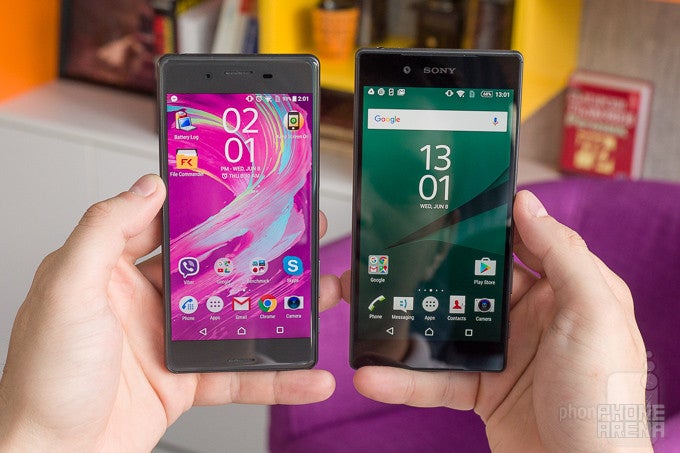
Introduction
Not even a day has gone by this past year without someone, somewhere, pondering over the unfortunate fate of esteemed manufacturers of old. Nokia, BlackBerry, even HTC, all are having trouble staying relevant in an increasingly murderous smartphone market. Worse yet, Sony has also been having quite some trouble as of late.
In a highly visible attempt to swing its fortunes for the better, Sony recently made the decision to discontinue its flagship Xperia Z-series and transition to a bit less-exclusive Xperia X branding for its higher-ends. The eponymous Xperia X was our first handshake with this new lineup, but keep in mind that the upcoming Xperia X Performance is the higher-end device that is likely meant to supersede the Z5.
That said, let's see if the more mainstream Xperia X, with its lighter specs sheet, can fill the Xperia Z5's shoes.
Design
There's no denying, we're fond of Sony design, at least as far as aesthetics go. Even more so lately, with phone makers the world over adopting round form factors when designing their gadgets. Elegantly rounded, the Xperia X and Xperia Z5 are among the few standing rectangular phones of the day, and that means something if you value differentiation.
Of the two, it's hard to pick a favorite, for both have their advantages and downsides. The newer X is decidedly more minimalist, with four counts of branding insignia forgone, and with a cleaner frame. It also features a curved glass for the display that seeps into said frame, unlike the Z5 which looks a bit more ordinary from the front.
The frame of the Z5 sticks out ever so slightly at the back, cutting into our hand when operating the phone—an issue taken care of with the X. Unfortunately, both remain very slippery devices in general, though this is compounded by the aforementioned issue with the Z5.
The Xperia Z5 is also a just a bit wider and taller than the X due to its larger screen, though it is slightly thinner overall. Not too bad considering the screen gains and the fact that the former is dust-proof and water-resistant, while the X isn't.
Display
We ought to start with a simple fact: the 1080 x 1920 pixel resolution displays on the two phones are very different from each other. And not just in terms of size, with the Xperia Z5's 5.2-incher to the Xperia X's 5-incher, but also in terms of display properties.
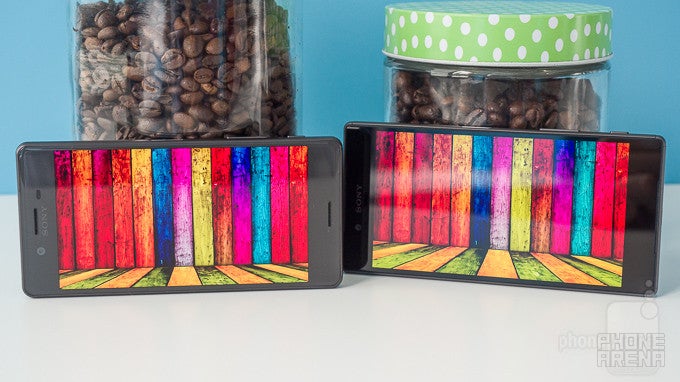
Starting with color temperature, both the Xperia X and Z5 have rather bluish screens, with the X's deviation from the reference colors being more extreme. The Z5 does win out on overall color accuracy, with a better—but not much better—representation. The Z5's 5.2-inch panel also offers higher brightness, so it's better suited for the upcoming summer months.
Going back to color, it's worth noting that both devices let you manually tweak (apart from choosing between two pre-made profiles) color temperature. If you know what you're doing, you can set these so that you get a more realistic image. Most people won't.
Interface and functionality
Always one for simplicity, the interface design team at Sony delivers very familiar UIs with both devices. Suffice to say that if you've used a Sony Xperia high-end from the past two or three years, you'll feel right at home with either. And even if you haven't tried out Sony's Xperia UI before, it's likely that you won't feel lost.
With both devices, we have highly minimalist interfaces that are geared towards people who don't necessarily subscribe to the more is better mantra. Extra features, therefore, are few and far between compared to the likes of Samsung or LG. And while there have been some changes to iconography and there are some gaps in overall functionality, overall the Xperia X and Z5 offer an essentially identical experience.
Standout features include the ability to wake up and sleep the screen by double tapping the screen, a decently stocked Theme store, and the ability to quickly jump into an app search from the Xperia X's homescreen with a swipe down, a la iOS.
Finally, it's important to note that in the States, neither of these two offers a fingerprint scanner for reasons unknown. For buyers in Europe, however, that feature is available.
Processor and memory
On paper, the main difference between the Xperia Z5 and Xperia X are the different chipsets driving them. Both are Qualcomm creations, sure, but the Z5 is outfitted with the higher-end, octa-core Snapdragon 810, while the X packs a hexa-core Snapdragon 650. In terms of peak performance, the 810 obviously offers superior results, though due to thermal throttling it typically has some trouble maintaining them.
This slight superiority extends to RAM on board. In terms of size, both are fitted with 3GB, but the Xperia X utilizes LPDDR3 RAM instead of LPPDR4 like the Z5. In result, the memory is less capable, if equal in size.
Looking past synthetic benchmarks, however, you'll be hard-pressed to notice a difference in day-to-day performance. Despite its less impressive silicone, the Xperia X moves about its interface with satisfying grace, rivaling the Z5. Load times are similar, frame rate within the interface is about the same, and overall we can't complain with the X. Where you're likely to notice a difference is with games, especially AAA titles with a lot of graphics fluff. When it comes to serious gaming, the Z5 is the clear pick.
Finally, on memory, we've got a draw. Both devices come with 32GB of storage standard, and offer expansion through a microSD card.
Internet and connectivity
Sony relies on a well-established, solid solution when it comes to browsing: Google's Chrome. And it pays off.

Sony relies on the well-established Chrome browser
As for connectivity features, the comparison isn't quite as clear cut. So while both devices offer support for 5GHz (or dual-band) Wi-Fi, NFC, DLNA, and Miracast technologies, the Xperia X pulls ahead with its Bluetooth 4.2 (compared to Bluetooth 4.1) and better LTE bands coverage. So while the Xperia Z5 can't be used on Sprint's or Verizon's LTE networks, the Xperia X can, though coverage won't be perfect—only one band is supported with Sprint, and two with Verizon, none of which the main LTE thread.
The Xperia Z5 has a few aces up its sleeve, though, with support for FM radio and MHL for wired streaming of your phone's screen to an external monitor.
Camera
Never one to skimp on camera tech, Sony has included tantalizing hardware with both the Xperia Z5 and Xperia X. Since they share the same setup, we're looking at a 1/2.3”, 23-megapixel snapper with wide, f/2.0 aperture lens and a single LED flash. Both units make use of Sony's excellent digital stabilization software, though only the X comes with the new predictive autofocus tech. Up front, the Xperia X comes with a 13-megapixel selfie cam, whereas the Z5 sports a 5-megapixel unit.

On the software side, it's once again nigh impossible to differentiate the two, as they feature the same new, minimalist Sony Camera app with its down-to-the-point interface. Clutter is minimal and you switch between various modes by swiping up and down through the menu on the left hand side. The special Modes menu of old is still available and provides access to various other creative and functional shooting modes.
Changing gears to image quality, you'd imagine that both devices offer essentially identical performance, but you'd be actually wrong to think so. Overall, and without a doubt in our mind, the Xperia Z5 is the more consistent, superior cameraphone.
There are several reasons for this. First and perhaps foremost, despite the fact that both devices seem to have imperfect lens that blur the image towards the edge, this issue was less pronounced with the Xperia Z5, if only by a little bit. Moreover, the camera on the X sometimes failed to resolve very fine, linear detail, introducing moiré. Noise is also higher with the Xperia X. We also couldn't help but once again notice those weird white spot artifacts present when viewing the photos in actual size.
Thanks to its higher resolution front camera, however, the Xperia X wins out with selfies. Its unit offers more detail, less noise, and a more appropriate, 4:3 aspect ratio that we'd prefer for group photos and most solo acts.
Finally, in terms of video, the Xperia Z5 notches a win again, thanks to its ability to capture 4K UHD video. Both devices can also shoot 1080 x 1920 resolution video at 30 or 60 frames per second, along with timelapse video.
Multimedia
With Sony targeting the much wider color gamuts that are used in the movie industry with the displays on the Z5 and the X, you'd think that you're getting a great multimedia device. But that's not really the case.
Sure, both displays are large enough to allow for some enjoyment out of movie watching, but do keep in mind that even if you do happen to have content that is intended to be viewed on such wide gamut displays, Android will not be able to interpret it. This results in overblown colors across the board.
The other main component, audio, is no better with either. Both offering front-firing stereo speakers, the Xperia Z5's set is... louder, which is great, especially considering how much trouble we've been having actually hearing our ringtone with the X. Audio quality, however, is slightly better with the new phone.
Call quality
Call quality with the Xperia X and Xperia Z5 is highly similar, regardless of whether you're looking at earpiece or microphone performance.
With both, the earpiece is superior to their respective microphone, delivering relatively clear and tonally correct voices that we immediately recognize. In the big scheme of things, we'd rank them better than average.
On the other end, however, things aren't as good. The microphone lacks power, so the other side will have trouble making out everything you say in a busy environment. For what it's worth, however, the Xperia X's unit is slightly more powerful.
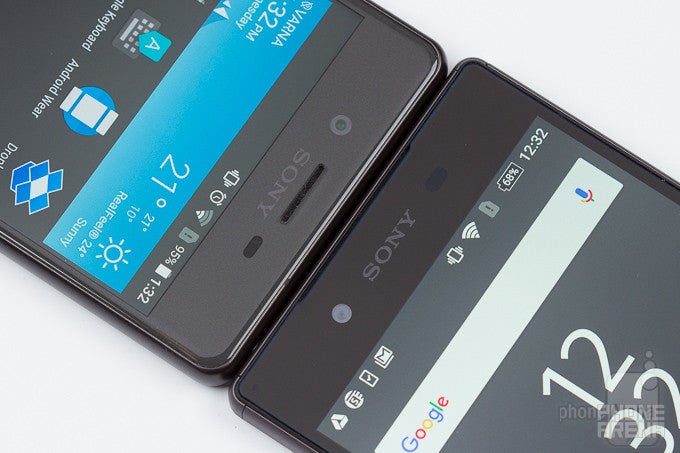
Battery life
In terms of total capacity, the 2,900mAh cell of the Xperia Z5 has the lead over the 2,620mAh unit of the Xperia X. But as you should know by now, numbers are just numbers.
Indeed, we found the numbers to be unrepresentative of our experience, with the Xperia Z5 offering worse battery performance with perhaps a 10% drop in longevity compared to the X. Not a massive advantage for the newer device, sure, but still something to keep in mind. Obviously, this ratio can vary wildly depending on what your typical usage looks like.
When it comes to charging times, the Xperia X, with its smaller juicer getting filled up some 15 minutes quicker than the larger unit of the Z5.
Conclusion
Available for order at $549.99, the Xperia X is a smartphone that doesn't disappoint, but feels a bit too expensive for what it offers. And thanks to its seniority, the Xperia Z5 is dangerously close in terms of pricing—nowadays you can score one for as little as $600.
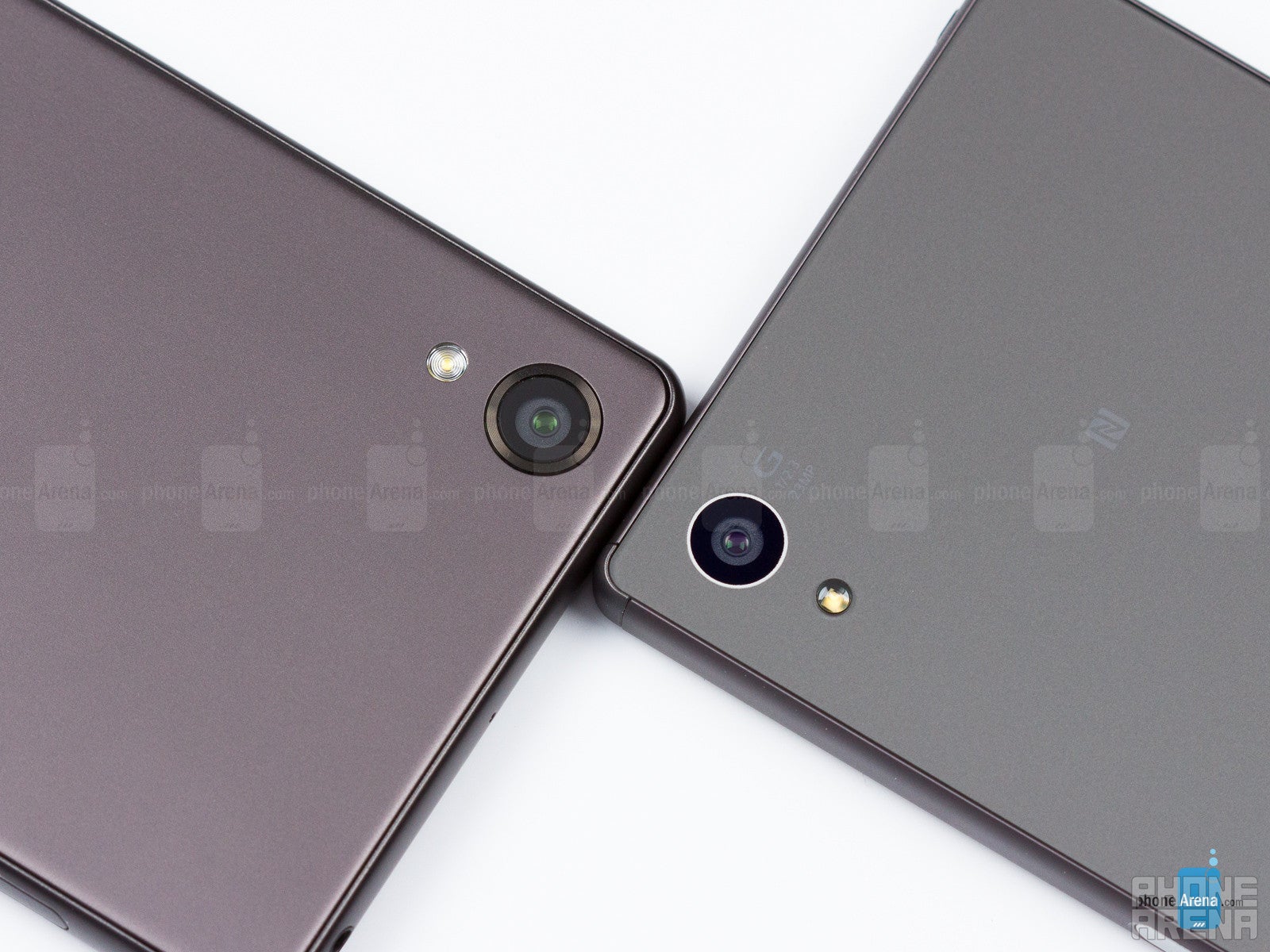
Our opinion? If you can get the Xperia Z5 for as much as $100 extra over the X, it's worth it. If you can't, go for the Xperia X
Sony Xperia X
Pros
- More ergonomic design
- Superior outdoor visibility
- Better battery life
- Better selfie camera
Sony Xperia Z5
Pros
- Less color-incorrect display
- Better-suited for heavy gaming
- Superior camera with 4K UHD video capture
- Stronger loudspeaker volume

Follow us on Google News


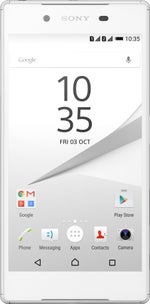












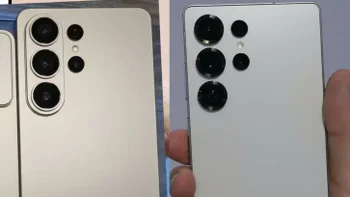








Things that are NOT allowed:
To help keep our community safe and free from spam, we apply temporary limits to newly created accounts: